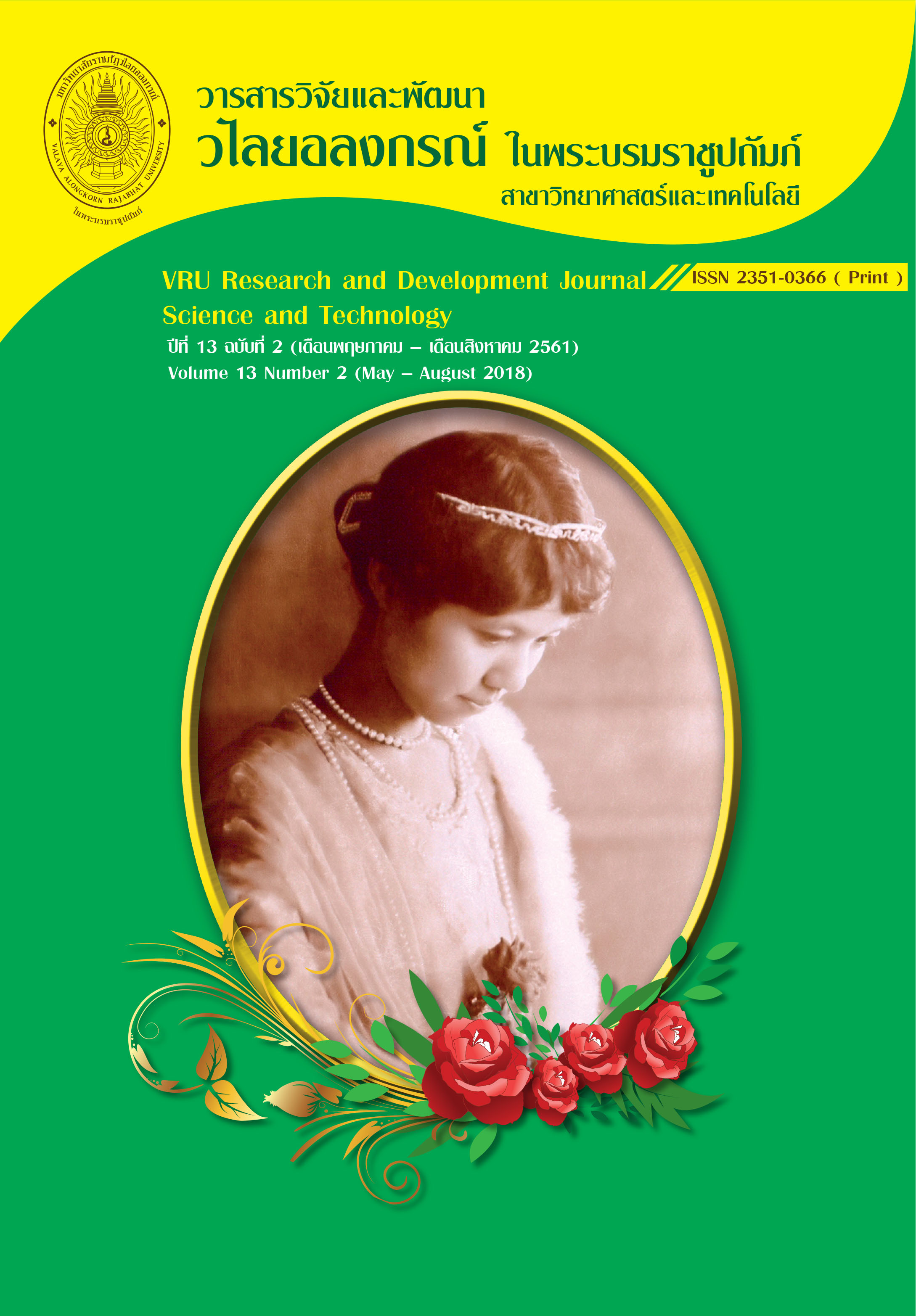SCREENING AND IDENTIFICATION OF POLYUNSATURATED FATTY ACID PRODUCING BACTERIA BY SIMPLIFIED METHOD
Main Article Content
Abstract
Nowadays, polyunsaturated fatty acid (PUFAs) has been intensively interested since they possess the vital roles in the human health, implicated in pharmaceutical and health products. The objectives of this study were isolation of the PUFAs producing bacteria through the simplified method within short period of time based on an application of antioxidative effect of PUFAs against to the oxidizing agent. Here, the screening of PUFAs producing bacteria was performed by direct visualization using the 0.1% H2O2 plate assay. Five bacterial isolates including SS_Sa2, SS_Sa1.1, KT_W1Y, BK_PD3 and BK_SD4 were exhibited in the presence of H2O2 through the intracellular PUFA production. In addition, the bacterial identification was then confirmed by using 16S rDNA sequencing analysis followed by phylogenetic relationship evaluation. Five PUFAs producing bacteria were successfully classified as Pseudoxanthomanas sp., Bacillus subtilis, Burkholderia sp., Vibrio sp. and Pseudomonas fluorescens, respectively. Therefore, the results would be proposed the diverse bacterial strains toward PUFA production and considerably activation of PUFA production providing the further nutraceutical and pharmaceutical industrial.
Downloads
Article Details
Copyright Notice
The copyright of research articles published in the VRU Research and Development Journal Science and Technology Journal belongs to the Research and Development Institute, Valaya Alongkorn Rajabhat University under the Royal Patronage. Reproduction of the content, in whole or in part, is prohibited without prior written permission from the university.
Responsibility
The content published in the VRU Research and Development Journal Science and Technology Journal is the sole responsibility of the author(s). The journal does not assume responsibility for errors arising from the printing process.
References
Albert, B. B., Cameron-Smith, D., Hofman, P. L. & Cutfield, W. F. (2013). Oxidation of marine omega-3 supplements and human health. BioMed Research International, 2013, http://dx.doi.org/10.1155/2013/464921
Dyall, S. C., & Michael-Titus, A. T. (2008). Neurological benefits of omega-3 fatty acids. Neuromolecular Medicine, 10, 219–235.
Elrazak, A. A., Ward, A. C. & Glassey, J. (2013). Polyunsaturated fatty acid production by marine bacteria. Bioprocess and Biosystems Engineering, 36, 1641-1652.
Horrobin, D. F. & Manku, M. S. (1983). Essential fatty acids in clinical medicine. Nutritional and Health, 2, 127-134.
Inglis, T. J. J., Aravena-Roman, M., Ching, S., Croft, K., Wuthiekanun, V. & Mee, B. J. (2003). Cellular fatty acid profile distinguishes Burkholderia pseudomallei from avirulent Burkholderia thailandensis. Journal of Clinical Microbiology, 41, 4812-4814.
Lane, D. J. (1991). 16S/23S rRNA sequencing In: Nucleic acid techniques in bacterial systematics (In: Stackebrandt, E. and Goodfellow, M., Eds.). New York, USA: John Wiley and Sons.
Nichols, D. S., Nichols, P. D. & McMeekin, T. A. (1993). Polyunsaturated fatty acids in Antarctic bacteria. Antarctic Science, 5, 149–160.
Nishida, T., Orikasa, Y., Ito, Y., Yu, R., Yamada, A., Watanabe, K. & Okuyama, H. (2006). Escherichia coli engineered to produce eicosapentaenoic acid becomes resistant against oxidative damages. FEBS Letters, 580, 2731–2735.
Patnayak, S., & Sree, A. (2005). Screening of bacterial associates of marine sponges for single cell oil and PUFA. Letters in Applied Microbiology, 40, 358-363.
Peiretti, P. G., Meineri, G., Longato, E. & Tassone, S. (2018). Nutritive value and fatty acid content of soybean plant [Glycine max (L.) Merr.] during its growth cycle. Italian Journal of Animal Science, 17, 347-352.
Pereira, S. L., Leonard, A.E. & Mukeri, P. (2003). Recent advances in the study of fatty acid desaturases from animals and lower eukaryotes. Prostaglandins, Leukotrienes and Essential Fatty Acids, 68, 97-106.
Russell, N.J. & Nichols, D. S. (1999). Polyunsaturated fatty acids in marine bacteria- a dogma rewritten. Microbiology, 145, 767-779.
Selvaraju, S., Raju, P., Rao, S. B., Raghavendra S., Nandi, S., Dineshkumar, D., et al. (2012). Evaluation of maize grain and polyunsaturated fatty acid (PUFA) as energy sources for breeding rams based on hormonal, sperm functional parameters and fertility. Reproduction fertility development, 24, 669-678.
Swanson, D., Block, R., & Mousa, S.A. (2012). Omega-3 fatty acids EPA and DHA: health benefits throughout life. Advances in Nutrition, 3, 1–7.
Teixeira, J. A. & Mota, M. (1992). Determination of catalase activity and its inhibition by a simple manometric method. Biochemical Education, 20, 174–175.
Tilay, A. & Annapure, U. (2012). Novel simplified and rapid method for screening and isolation of Polyunsaturated fatty acids producing marine bacteria. Biotechnology Research International, 2012. http://dx.doi.org/10.1155/2012/542721
Yoshida, K., Hashimoto, M., Hori, R., Adachi, T., Okuyama, H., Orikasa, Y., et al. (2016). Bacterial long-chain polyunsaturated fatty ccids: their biosynthetic genes, functions, and practical use. Marine Drugs, 14, https://doi.org/10.3390/md14050094
Zárate R., El Jaber-Vazdekis N., Tejera N, Pérez J. A. & Rodríguez C. (2017). Significance of long chain polyunsaturated fatty acids in human health. Clinical and Translational Medicine, 6, https://doi.org/10.1186/s40169-017-0153-6


